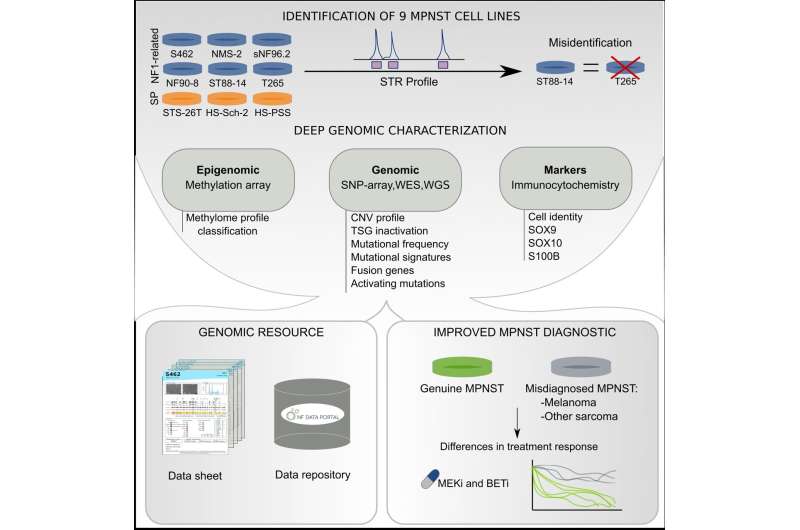This article has been reviewed according to Science X's editorial process and policies. Editors have highlighted the following attributes while ensuring the content's credibility:
fact-checked
peer-reviewed publication
proofread
Comprehensive genomic characterization of malignant peripheral nerve tumor-derived lines challenges diagnostic criteria

The Hereditary Cancer research group from the Germans Trias i Pujol Research Institute (IGTP) has led an international collaboration that has allowed the genomic characterization of the most commonly used cell lines derived from malignant peripheral nerve sheath tumors (MPNSTs).
This research has generated a detailed catalog of genomic alterations for each cell line, which can be used to develop strategies for precision therapies. At the same time, a genomic repository has been created that is open to all researchers interested in these tumors. The work has been published in the journal iScience.
One of the most notable results is that it provides new types of genomic information that complements the histological characterization of MPNSTS for a better and more accurate differential diagnosis of these tumors. In fact, the work has made it possible to identify that some of the lines supposedly MPNSTs, which have been used in multiple research studies, or which are deposited in cell line banks (ATCC, RIKEN), are not MPNSTs, but other tumor entities.
Dr. Miriam Magallón, first author of the study, comments "we have identified cell lines that were misdiagnosed, but we have also detected that two of the most commonly used lines as MPNSTs are actually the same cell line."
Drs Bernat Gel and Eduard Serra, the researchers who have led this work, emphasize that "this work is a great opportunity to use the new types of genomic information to revise the diagnostic criteria for these tumor types. We would like to lead a new international project in which pathologists, molecular biologists and bioinformaticians could systematically analyze and compare the histology of these tumors, together with their genomic data, to clarify what an MPNST is, if there are different subtypes, and what is not an MPNST."
Bernat Gel finally highlights "this study also opens the door to the development of new genomic analyses that facilitate the management of patients who are at high risk of developing MPNST, or who have already developed it, and require regular follow-up. Minimal biopsy or liquid biopsy-based analyses using new long-read sequencing technologies would be ideal for identifying the type of genomic alterations responsible for the development and progression of MPNSTs."
The IGTP Hereditary Cancer Group has been studying peripheral nervous system tumors associated with Neurofibromatosis type 1 for years, especially the progression from plexiform neurofibroma (PNF), to atypical neurofibroma (or ANNUBP), to malignant peripheral nerve sheath tumor (MPNST).
The two pillars of the characterization of these tumors by this group are genomic, epigenomic and bioinformatic analyses, on the one hand, and the development of cellular models that reliably represent these tumors, on the other. In relation to this point, the research group has just published a paper in the journal STAR Protocols explaining an experimental protocol for the generation of neurofibrospheres, a 3D model derived from induced pluripotency stem cells.
People with NF1 can develop from tens to thousands of cutaneous neurofibromas on their skin. These benign tumors, which originate in the nerve endings between the epidermis and dermis, are not life-threatening, but instead have a very high impact on their quality of life. These tumors can be disfiguring, discomforting, and can cover a person's body, significantly affecting self-esteem, socialization, etc.
The Hereditary Cancer group found that the combination of intracellular cAMP-raising agents, together with MEK (Raso/MAPK pathway) inhibitors, has a major impact on the viability of both primary Schwann cells derived from these tumors and a 3D model of neurofibrospheres derived from induced pluripotent stem cells (iPSCs).
With these promising results at the in vitro level, a project was presented within the NTAP initiative "Biology and Therapeutic Development (BTD) for Cutaneous Neurofibromas (cNFs) Application" to make the leap to two complementary animal models and collect pre-clinical in vivo data regarding this co-treatment. One of these models has been developed by Dr. Piotr Topilko in Paris and the other is a PDX model that results from grafting neurofibromespheres derived from iPSCs into the sciatic nerve of mice, in collaboration with the group of Dr. Conxi Lázaro and Dr. Juana Fernández, from the Institut d'Investigació Biomèdica de Bellvitge (IDIBELL).
The project will last three years and will be led by Dr. Helena Mazuelas, both in Barcelona and Paris, and coordinated by Dr. Meritxell Carrió and Dr. Eduard Serra.
More information: Miriam Magallón-Lorenz et al, Deep genomic analysis of malignant peripheral nerve sheath tumor cell lines challenges current malignant peripheral nerve sheath tumor diagnosis, iScience (2023). DOI: 10.1016/j.isci.2023.106096


















